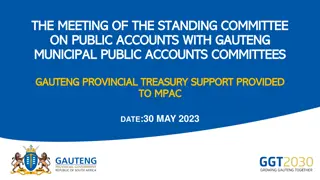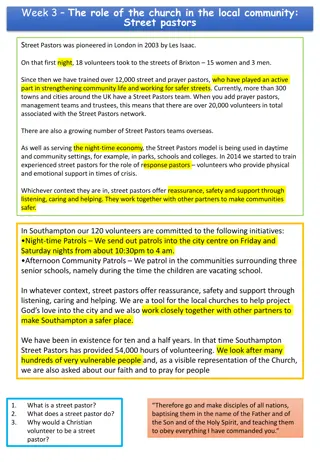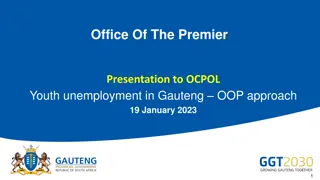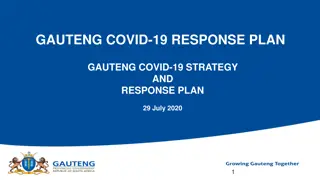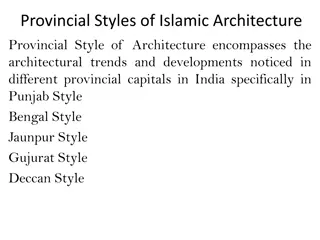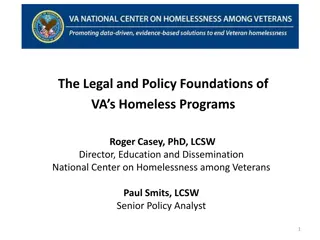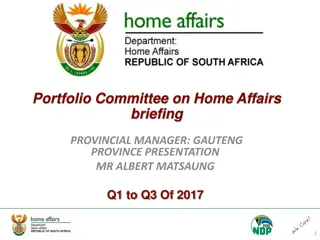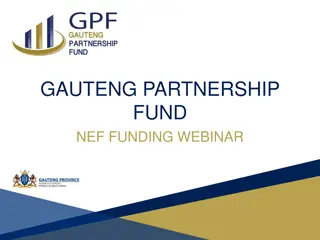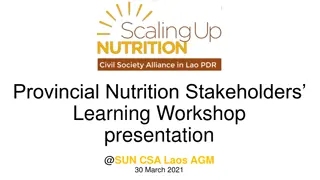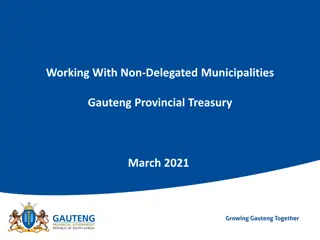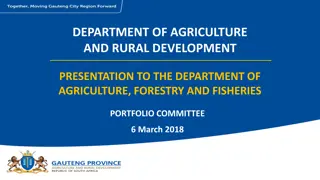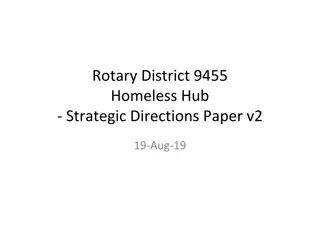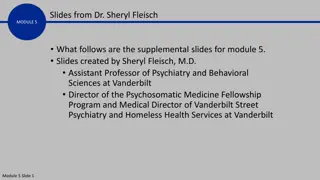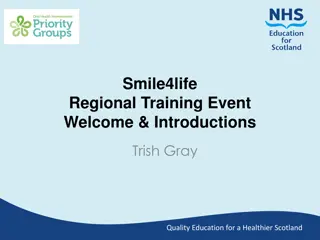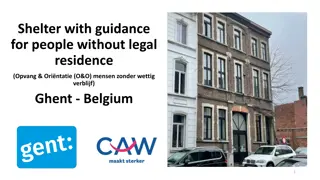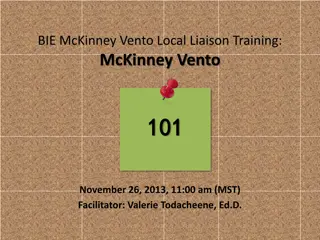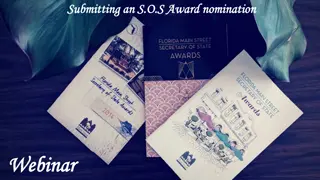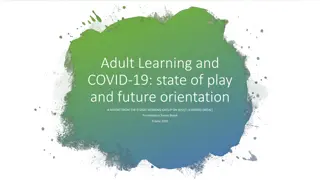Gauteng Provincial Strategy to Empower and Mitigate Adult Street Homeless People
The Gauteng Provincial Strategy aims to address the challenges faced by adult street homeless individuals by collaborating with municipalities and other organizations. It discusses the definitions of homelessness, the global homeless population, and the specific situation in South Africa. By sharing interventions and strategies, the presentation seeks to make a difference in the lives of those affected by homelessness.
Download Presentation

Please find below an Image/Link to download the presentation.
The content on the website is provided AS IS for your information and personal use only. It may not be sold, licensed, or shared on other websites without obtaining consent from the author.If you encounter any issues during the download, it is possible that the publisher has removed the file from their server.
You are allowed to download the files provided on this website for personal or commercial use, subject to the condition that they are used lawfully. All files are the property of their respective owners.
The content on the website is provided AS IS for your information and personal use only. It may not be sold, licensed, or shared on other websites without obtaining consent from the author.
E N D
Presentation Transcript
Gauteng Provincial Strategy to Empower and Mitigate Adult Street Homeless People Against Vulnerability: Progress and Challenges ASASWEI CONFERENCE DURBAN 27 SEPTEMBER 2023 DR E MULEYA; PROF M SOBANTU 1
OUTLINE OF THE PRESENTATION 1. Purpose 2. Background 3. Underpinning argument 4. Methodology 5. Discussion 6. Challenges and mitigation 7. Implications for social work 8. References 2
1.PURPOSE To share interventions on homelessness in terms of the Gauteng City Region Strategy on Street Adult homelessness working in collaboration with Municipalities , other Government Departments and NPOs. 3
2. BACKGROUND: DEFINING THE HOMELESS Many definitions for homelessness: The United Nations (2004) proposed a working definition of thehomeless to include people, families, households or individuals who do not have a shelter or living abode, within which they exercise basic human rights. While common image of homelessness is sleeping and living on the streets , homelessness takes many forms and is not always obvious as it may be chronic, episodic, transitional and hidden in nature (Ebioha, 2022). After consulting stakeholders, the HSRC adopted for its study a definition of homelessness that emphasises living on the street (Cross et al 2010; Rule- Groenewald et al, 2015; Roets et al. 2016; De Beer, & Valley, 2017). The Gauteng government through its GCR Strategy aligns itself with this definition (GDSD, 2021) 4
2. BACKGROUND: HOMELESS POPULATION Homelessness is a worldwide phenomenon, with an estimated homeless population ranging from 100 million to one billion or more, depending on how homelessness is defined (Roets et al. 2016) Reports of increases in the numbers of homeless people such developed countries as Australia, New Zealand, Canada and the USA and Europe (Kriel, 2015) and 610 042 people experienced homelessness in the USA on a single night in January 2013 (Henry et al., 2013, p. 1), Homelessness has also emerged as a major social and economic issue in the entire developing world (Kriel, 2015) It is equally difficult to determine the number of homeless people in Africa, but the latter is probably still the continent most affected by the scourge and tragedy of forced displacement (Kriel, 2015) 5
2. BACKGROUND: HOMELESS POPULATION The HSRC s results suggest there may be from 100 000 to 200 000 truly homeless street people in South Africa s urban and rural districts together, including both adults and children (Cross et al, 2010, Rule-Groenewald et al, 2015). Concentrated on Metros Cape Town 7 383, (4 862 are on the streets and the rest in shelters (Hendricks, 2015), Durban 4 000 streets or in the formal shelters ( Desmond et al, 2017:2; City of Ethekwini 16000, Point In Time survey, 2022 ), Johannesburg (15 000 on the streets (Borgen Projects: 2023 and lastly Tshwane with 6244) Currently, the population of the homeless in government funded shelters across Gauteng is around 2700, with the City of Johannesburg and Tshwane accounting for the larger portion of these. 6
2. DISCUSSION HOMELESS POPULATION Other African Countries 7% Country of Birth European Countries 0% South Africa 93% South Africa Other African Countries European Countries 7 Source: NDSD Diagnostic Study Sonko-Najjemba et al., 2022)
2. BACKGROUND: HOMELESS POPULATION Age Groups by Residence Type Age Groups by Residence Type 50% 40% 30% Axis Title 20% 10% 0% 25-34 30% 48% 35-49 36% 27% 50-64 21% 6% 18-24 7% 18% 65 and older 4% 0% 15-17 2% 1% Under 15 1% 1% Shelter Street 8 Source: NDSD Diagnostic Study (Sonko-Najjemba et al., 2022)NDSD Diagnostic Study Sonko-Najjemba et al., 2021)
3. UNDERPINNING ARGUMENT In terms of the Bill of Rights, the state must respect, protect, promote and fulfil the rights of all citizens namely access to health care, food ,water, social security , housing etc yet in most instances homeless people lack access to most of these rights (De Beer & Vally, 2021; Perrier, 2021). It is on the basis of protection of human rights of homeless people that the Department decided to intervene in the plight of this vulnerable group. The mandate of the Department of Social Development (DSD) is to ensure protection against vulnerability by creating an enabling environment for the provision of a comprehensive, integrated and sustainable social development service 9
4. METHODOLOGY Systemic review: Qualitative data from academic journals, literature in the field and reliable internet sources subjected to content analysis and synthesis Development Southern Africa Volume 27, Issue 1 (2010), on Street people in South Africa: Studies towards understanding the homeless in South Africa and then downloaded all 11 articles featured and Sorted for relevance Development Southern Africa, Volume 34, Issue 4 (2017), Special issue: Pathways out of Homelessness and then downloaded all 11 articles featured and sorted for relevance Practice observation: 1Presenter Policy Developer at Gauteng Department of Social Development, involved data reporting 10
5. DISCUSSION: HOMELESS Pre-Covid Nationally: Debates on mandates Local Government vs National DSD (Cross et.al 2010; Obioha, 2019 ) Only three Municipalities with policies to address homelessness (City of Cape Town 2013, City of Tshwane, 2015 and City of Joburg Draft revised 2022 (De Beer and Vally, 2021) One province: (WC Provincial Government: 2015 based on Norms & Standards) GDSD: Four homeless shelters, one in Sedibeng and three in the City of Johannesburg and 2 Metros had policy on homelessness 11
5. DISCUSSION: HOMELESS Covid and Aftermath For the first time, the United Nations has adopted resolution 76/133 in December of 2021, on ending homelessness and recognizing homelessness as an affront to human dignity. The Secretary-General has to report to member states Sixth going seventh National Conversations on Homelessness (De Beer, & Vally, 2021) Involvement of more municipalities on addressing homelessness with draft policies (De Beer and Vally, 2021) National DSD research on needs of homeless (Sonko-Najjemba et al., 2022) and targeting the Draft Green Paper on Homelessness by March 2024 (NDSD) National dialogue on homelessness from a law enforcement perspective, 6-7 September 2023 12
5. DISCUSSION: HOMELESS The causes, extent and nature of homelessness in South Africa and some of the responses to homelessness have been addressed in the 1st Issue (March 2010) (Cross et al, 2010) and 4th Issue of 2017 of Development Southern Africa and cannot be discussed within the confines of this presentation Homelessness is a product of multipronged agents that shape and are being shaped by both economic as well as social circumstances that prevail in the country (Obioha, 2022, Sonko-Najjemba et al., 2021; 2022) Findings incorporated into final Gauteng City Region Strategy on Adult Street Homelessness 13
5. DISCUSSION: HOMELESS -EMPOWERMENT APPROACH TO HOMELESSNESS Usually Approaches Pathologizing homelessness (welfare/health), Criminalizing homelessness (law enforcement) Our Approach: - Addressing it holistically in a developmental & rights-based manner, through a multi- stakeholder (whole-of-society approach) understanding it as an expression of structural failure Therefore: ensuring welfare, health, housing, economic access, access to justice, and protection of human dignity, all featuring together, in ways that break cycles of exclusion and poverty and Contributing to a self-reliant society. 14
3. 5. DISCUSSION: HOMELESS (PROGRESS) GCR STRATEGIC PILLARS PROGRESS Pillar 1 - Advocacy, prevention of crisis and early intervention Pillar2 - Provision of housing, safe spaces, drop-in and shelters to prevent and support homeless people Annual commemoration of world homeless day, concerted efforts on homeless conversation, awareness and outreach reaching Funding for park or container homes replacing marquees or tents or community centres : 498 expanded space plus 1 unused building with potential 500 spaces Engagement with DHS for RDP housing: 6 successful Funding existing NPO/Municipality shelters:30 Funding for park or container homes replacing marquees or tents or community centres : 498 Funding existing NPO/Municipality 366 provided with identity documentation 1080 successfully reunited with family Accredited skills development 542 and job placement 974 incl EPWP, 43 started own jobs Pillar 3 - Social inclusion through social security and social welfare/ transfers to NPOs, indigent programme, family reunification Pillar 4 - Skills Development and economic inclusion financial for self employment/business startup, job placement etc) Pillar 5 - Integrated persons centred system Provincial and Regional Fora was established to promote intersectoral collaboration 15
6.CHALLENGES AND MITIGATIONS Challenges Mitigations 1.Increasing number of homeless people Outreach programme to be implemented Mobile drop in centre services and need more shelters Rely on the statistics from Stat South Africa 2.Unavailability of reliable statistics for homelessness in the country 4. Commitment by all stakeholders to provide service to homeless people Continue to strengthen the Provincial and Regional Fora 5. Some homeless people do not want to be admitted in shelters Safe spaces to be established 6. Criminalization of homelessness Explore social development options before law- enforcement 16
7. RECOMMENDATIONS AND IMPLICATIONS FOR SOCIAL WORK Against the observation on the present homelessness situation in South Africa, the following recommendations are made: It should be noted that a starting point to address homelessness is adequate data, both for monitoring target 11.1 of the Sustainable Development Goals and for formulating effective policies and social work research should play a role both in quantification of data but also its measuring impact starting with GCR Strategy Social work needs to influence national policy on homelessness. Noyoo (2010, p. 23) emphasises that policy measures [should] protect the welfare of the vulnerable in society and promote social justice and human rights of vulnerable populations There is a correlation between street homelessness and their vulnerability to many forms of abuse and therefore this is a social work concern that this conference should deliberate on. 17
6.REFERENCES Cross, C & Seager, JR, 2010. Towards identifying the causes of South Africa s street homelessness: Some policy recommendations. Development Southern Africa, 27(1), 143 58. doi:10.1080/03768350903519416 Cross, C, Seager, J, Erasmus, J, Ward, C & O Donovan, M, 2010. Skeletons at the feast: A review of street homelessness in South Africa and other world regions. Development Southern Africa 27(1), 5 20. doi:10.1080/03768350903519291 De Beer, S & Vally, R, 2017. (Finding) Pathways out of homelessness: An engaged, trans-disciplinary collaborative in the City of Tshwane, Development Southern Africa, 34, 4, 385-398, DOI: 10.1080/0376835X.2017.1319261 De Beer & Vally, R (Eds), (2021). Facing homelessness finding inclusionary, collaborative solutions. AOSIS Du Toit, JL, 2010. Local metropolitan government responses to homelessness in South Africa. Development Southern Africa 27(1), 111 28. doi:10.1080/03768350903519390 Haralambos, M, Holborn, M & Heald, R, 2004. Sociology: Themes and perspectives. 6th Edition. Harper Collins Publishers, London. Killander, M, 2019. Criminalising homelessness and survival strategies through municipal by-laws:Colonial legacy and constitutionality. South African Journal on Human Rights 35, 70 93. doi:10.1080/02587203.2019.1586129 Kok, P, Cross, C & Roux, N, 2010. Towards a demographic profile of the street homeless in South Africa. Development Southern Africa 27, 21 37. doi:10.1080/03768350903519309 18
6.REFERENCES Mahlangu T & Kgadima P, 2021. Social exclusion and marginalisation of homeless people: a clarion social work call for the spirit of ubuntu to reign. Social Work/Maatskaplike Werk, 57(4), 45-57. Makiwane, M, Tamasane, T & Schneider, M, 2010. Homeless individuals, families and communities: The societal origins of homelessness. Development Southern Africa 27(1), 39 49. doi:10.1080/03768350903519325 Naidoo, V, 2010. Government responses to street homelessness in South Africa. Development Southern Africa 27(1), 129 41. doi:10.1080/03768350903519408 Obioha, E.E, 2022. State response to homelessness in South Africa: A multi-agency housing focused intervention approach considered, Development Southern Africa, 39, 6, 990-1006, DOI: 10.1080/0376835X.2022.2103519 Perrier, R., 2021, The Rights Revolution in South Africa: How can the homeless benefit? , in S. de Beer & R. Vally (eds.), Facing homelessness: Finding inclusionary, collaborative solutions, pp. 63 93, AOSIS, Cape Town. https://doi.org/10.4102/aosis.2021. BK239.03 Roets, L, Botha, A, Greeff, M, Human, SP, Strydom, H, Watson, MJ & Chigeza, S, 2016. A synthesis of homelessness in South Africa: A rapid critical appraisal. Development Southern Africa 33(5), 613 27. doi:10.1080/0376835X.2016.1203756 Rule-Groenewald, C, Timol, F, Khalema, E & Desmond, C., 2015. More than just a roof: Unpacking homelessness. HSRC, Pretoria. https://hsrc.ac.za/en/review/hsrc-review-march-2015/unpacking-homelessness Sonko-Najjemba, R., Mataboge, R., Lelaka, T., Kamoga, N., Chabawarwa, T., Oladokun, P., Sonko, G., Cindi, J., & Mtoba, C. (2021). An assessment of the needs of Homeless people in Gauteng Province, in the context of COVID-19. Strategic Analytics and Management (PTY) Ltd. UN, 2020. Affordable housing and social protection systems for all to address homelessness. Report of the Secretary General. Commission for Social Development Fifty-eighth session 10 19 February 2020. 19



